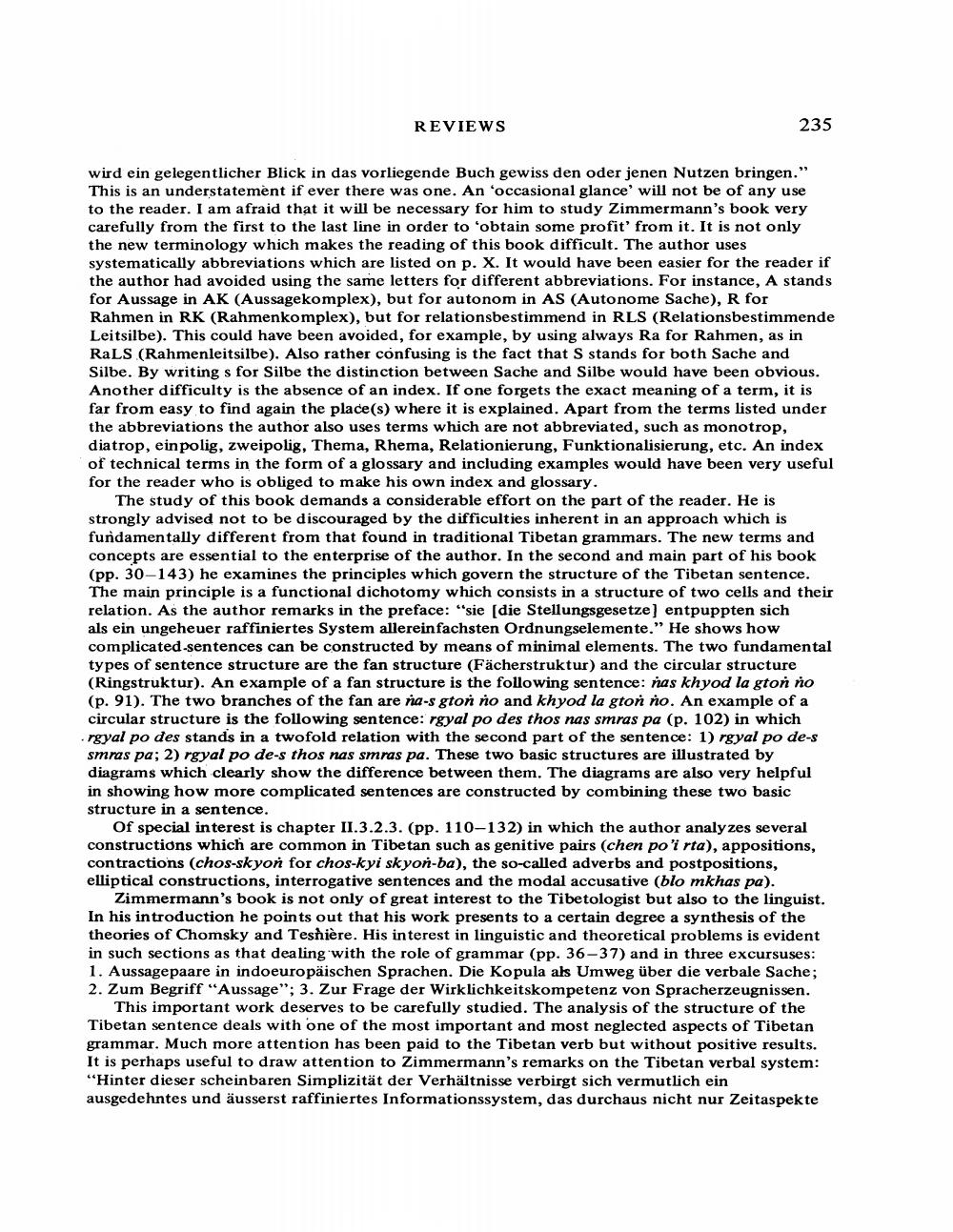________________
REVIEWS
235
wird ein gelegentlicher Blick in das vorliegende Buch gewiss den oder jenen Nutzen bringen." This is an understatement if ever there was one. An 'occasional glance' will not be of any use to the reader. I am afraid that it will be necessary for him to study Zimmermann's book very carefully from the first to the last line in order to obtain some profit' from it. It is not only the new terminology which makes the reading of this book difficult. The author uses systematically abbreviations which are listed on p. X. It would have been easier for the reader if the author had avoided using the same letters for different abbreviations. For instance, A stands for Aussage in AK (Aussagekomplex), but for autonom in AS (Autonome Sache), R for Rahmen in RK (Rahmenkomplex), but for relationsbestimmend in RLS (Relationsbestimmende Leitsilbe). This could have been avoided, for example, by using always Ra for Rahmen, as in RaLS (Rahmenleitsilbe). Also rather confusing is the fact that S stands for both Sache and Silbe. By writing s for Silbe the distinction between Sache and Silbe would have been obvious. Another difficulty is the absence of an index. If one forgets the exact meaning of a term, it is far from easy to find again the place(s) where it is explained. Apart from the terms listed under the abbreviations the author also uses terms which are not abbreviated, such as monotrop, diatrop, ein polig, zweipolig, Thema, Rhema, Relationierung, Funktionalisierung, etc. An index of technical terms in the form of a glossary and including examples would have been very useful for the reader who is obliged to make his own index and glossary.
The study of this book demands a considerable effort on the part of the reader. He is strongly advised not to be discouraged by the difficulties inherent in an approach which is fundamentally different from that found in traditional Tibetan grammars. The new terms and concepts are essential to the enterprise of the author. In the second and main part of his book (pp. 30-143) he examines the principles which govern the structure of the Tibetan sentence. The main principle is a functional dichotomy which consists in a structure of two cells and their relation. As the author remarks in the preface: "sie (die Stellungsgesetze) entpuppten sich als ein ungeheuer raffiniertes System allereinfachsten Ordnungselemente." He shows how complicated sentences can be constructed by means of minimal elements. The two fundamental types of sentence structure are the fan structure (Fächerstruktur) and the circular structure (Ringstruktur). An example of a fan structure is the following sentence: nas khyod la gton no (p. 91). The two branches of the fan are na-s gton no and khyod la gton no. An example of a circular structure is the following sentence: rgyal po des thos nas smras pa (p. 102) in which rgyal po des stands in a twofold relation with the second part of the sentence: 1) rgyal po de-s smras pa; 2) rgyal po de-s thos nas smras pa. These two basic structures are illustrated by diagrams which clearly show the difference between them. The diagrams are also very helpful in showing how more complicated sentences are constructed by combining these two basic structure in a sentence.
Of special interest is chapter II.3.2.3. (pp. 110-132) in which the author analyzes several constructions which are common in Tibetan such as genitive pairs (chen po'i rta), appositions, contractions (chos-skyon for chos-kyi skyon-ba), the so-called adverbs and postpositions, elliptical constructions, interrogative sentences and the modal accusative (blo mkhas pa).
Zimmermann's book is not only of great interest to the Tibetologist but also to the linguist. In his introduction he points out that his work presents to a certain degree a synthesis of the theories of Chomsky and Tesħière. His interest in linguistic and theoretical problems is evident in such sections as that dealing with the role of grammar (pp. 36-37) and in three excursuses: 1. Aussagepaare in indoeuropäischen Sprachen. Die Kopula als Umweg über die verbale Sache; 2. Zum Begriff "Aussage"; 3. Zur Frage der Wirklichkeitskompetenz von Spracherzeugnissen.
This important work deserves to be carefully studied. The analysis of the structure of the Tibetan sentence deals with one of the most important and most neglected aspects of Tibetan grammar. Much more attention has been paid to the Tibetan verb but without positive results. It is perhaps useful to draw attention to Zimmermann's remarks on the Tibetan verbal system: "Hinter dieser scheinbaren Simplizität der Verhältnisse verbirgt sich vermutlich ein ausgedehntes und äusserst raffiniertes Informationssystem, das durchaus nicht nur Zeitaspekte




